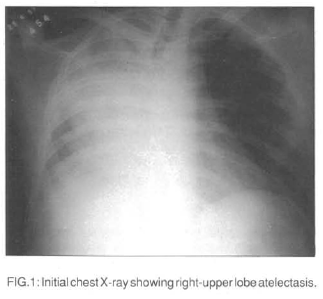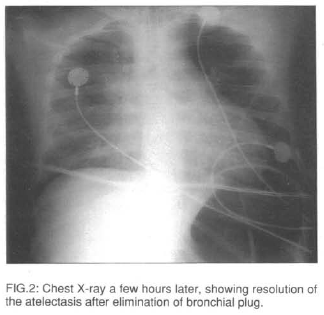Abstracts
A 22-year-old man in his first relapse of T-acute lymphoblastic leukemia developed fever and a pulmonary infiltrate after 23 days of granulocytopenia. Although having been under amphotericin B for 10 days, productive purulent cough ensued, with right lobe atelectasis and acute ventilatory failure that resolved after the elimination of a thick gelatinous bronchial plug. Sputum cultures yielded Candida Albicans and Staphylococcus epidermidis, and microscopic examination of the sputum plug disclosed Aspergillus hyphae. The patient died 9 days after, of a disseminated Aspergillus infection, confirmed by necropsy.
aspergillosis; atelectasis; leukemia
Aspergilose pulmonar: causa infrequente de atelectasia e asfixia em paciente Ieucêmico. Paciente de 22 anos em primeira recidiva de leucemia linfóide aguda de tipo T desenvolveu febre e infiltrado pulmonar após 23 dias de granulocitopenia. Apesar do uso de Anfotericina B, houve progressão da doença pulmonar com aparecimento de expectoração purulenta, atelectasia do pulmão direito e insuficiência ventilatória. Esta foi resolvida após eliminação de rolha brônquica espessa. Culturas de escarro revelaram Candida Albicans e Staphylococcus epidermidis ; a microscopia óptica da rolha revelou a presença de hifas de aspergilos. O paciente foi a óbito 9 dias após, par infecção disseminada por aspergilos, confirmada por necrópsia.
ORIGINAL ARTICLE
Aspergillary bronchopneumonia: an unusual cause of atelectasis and asphyxia in a leukemic patient
Elvira Deolinda Rodrigues Pereira Velloso; Gracia Aparecida Martinez; Pedro Enrique Dorlhiac-Llacer; Dalton Alencar Fischer Chamone
Department of Hematology, General Clinical Hospital Medical School of São Paulo University - São Paulo - Brazil Fundação Pró-Sangue/Hemocentro of São Paulo
Address for correspondence Address for correspondence: Dra. Elvira D. R. P. Velloso Fundação Pró-Sangue/Hemocentro de São Paulo Av. Dr. Enéas de Carvalho Aguiar, 155, PAMB 10º andar São Paulo - SP - Brasil - CEP 05403-000
ABSTRACT
A 22-year-old man in his first relapse of T-acute lymphoblastic leukemia developed fever and a pulmonary infiltrate after 23 days of granulocytopenia. Although having been under amphotericin B for 10 days, productive purulent cough ensued, with right lobe atelectasis and acute ventilatory failure that resolved after the elimination of a thick gelatinous bronchial plug. Sputum cultures yielded Candida Albicans and Staphylococcus epidermidis, and microscopic examination of the sputum plug disclosed Aspergillus hyphae. The patient died 9 days after, of a disseminated Aspergillus infection, confirmed by necropsy.
Uniterms: aspergillosis, atelectasis, leukemia.
RESUMO
Aspergilose pulmonar: causa infrequente de atelectasia e asfixia em paciente Ieucêmico.
Paciente de 22 anos em primeira recidiva de leucemia linfóide aguda de tipo T desenvolveu febre e infiltrado pulmonar após 23 dias de granulocitopenia. Apesar do uso de Anfotericina B, houve progressão da doença pulmonar com aparecimento de expectoração purulenta, atelectasia do pulmão direito e insuficiência ventilatória. Esta foi resolvida após eliminação de rolha brônquica espessa. Culturas de escarro revelaram Candida Albicans e Staphylococcus epidermidis ; a microscopia óptica da rolha revelou a presença de hifas de aspergilos. O paciente foi a óbito 9 dias após, par infecção disseminada por aspergilos, confirmada por necrópsia.
Patients with acute leukemia andgranulocytopenia are at a high risk of fungal infection, specially-involving Aspergillus species. Aspergillus infections involve primarily the lung, causing a necrotizing bronchopneumonia with angiitis and infarction. In this pa-per we report a case of pulmonary aspergillosis with an unusual evolution to atelectasis and asphyxia in a leukemic patient.
CASE REPORT
A 22-year-old man with T-acute lymphoblastic leukemia (T-ALL) was admitted to the hospital in the first relapse of the disease, for chemotherapy.
A bone marrow aspirate revealed 48% blasts, and peripheral blood demonstrated 11,6 g/dl hemoglobin; 3,2 x 109/l white blood cells with 53% granulocytes, and 148x 109/l platelets.
Six days after the first course of Mitoxantrone and Cytosine-arabinoside, the granulocyte count fell to 0,5 x 109/1. Four days later, the patient developed celulitis in the right foot and fever, with negative blood and skin cultures. Vancomycin, Amikacin and Ceftazidime were started, as well as G-CSF, and the infection subsided. Neutropenia persisted, and a bone marrow aspirate showed lymphoblasts.
Twenty days later, 11 days after the second course of chemotherapy with the same drugs, the fever reappeared. A chest roentgenogram showed a right infra-hilar pulmo-nary infiltrate. Treatment with Amphotericin B was started at a dose of 0.5mg/(Kg.d) and increased to 1.0 mg/(Kg.d).
As pancytopenia and bone marrow infiltration persisted, chemotherapy with VAD was started. The patient's condition worsened, with progressive dyspnea and productive cough.
The blood cultures were negative, and sputum culture yielded Staphylococcus epidermidis and Candida Albicans.
One week later, dyspnea became very intense. A chest X-Ray showed atelectasis of the rigth upper lobe (figure 1).
After a few hours stridor developed, and complete atelectasis of the right lung was shown in a subsequent radiography.
Orotracheal intubation was required, but the patient eliminated a 7x3 cm sputum plug during the procedure, with subsequent improvement of respiratory conditions and reversion of atelectasis (figure 2).
The specimen revealed Aspergillus hyphae at light microscopy.
The patient died 9 days after and the necropsy showed disseminated aspergillosis, with multiple septic embolus in mediastinal lymph nodes, trachea, bronchi, lungs, peri-cardium, stomach and small and large intestines.
DISCUSSION
Fungal infection have become an increasingly commom problem in immunocompromised hosts. The most affected patients are those with hematologic neoplasms, and organ-transplant recipients given long-term immuno-suppressive therapy (4).
Of systemic mycoses in cancer patients, candidiasis is the most common, followed by aspergillosis (3). A high incidence of Aspergillus infection (20-30%) have been reported among patients with acute leukemia (1). The risk factors for Aspergillus infection include the use of antibiotics, corticosteroids and chemotherapy, as well as granulocytopenia (1). The duration of granulocytopenia is the major risk factor for aspergillosis in patients with acute leukemia. The incidence of invasive aspergillosis increases in close correlation with the number of days of granulocytopenia, approximating 4,3% per day between the 24th and the 36th days (2).
Aspergillus are ubiquitous in Nature and are acquired primarily through the respiratory (bronchial tree and paranasal sinuses) and gastrointestinal tracts.
In immunosuppressed patients the lungs are involved in nearly 80% of Aspergillus infections. In these patients, the pulmonary disease rarely is of the saprophytic (mycetomas) or allergic (allergic bronchopulmonary aspergillosis) forms (3,7). Chronic necrotizing pulmo-nary aspergillosis and invasive pulmonary aspergillosis are the most common presentations of this disease in cancer patients (5,7). The finding of pulmonary infiltrates in a febrile granulocytopenic patient receiving broad-spectrum antibiotic therapy is the most frequent aspect of aspergillosis (4). Pleuritic chest pain, pleural friction rub, nonproductive cough, hemoptisis and hipoxemia are common findings (4,6). Aspergillary bronchitis or endobronchial disease is a localized form of aspergillosis, characterized by bronchial casts containing mucus and mycelia and is an unusual pulmonary manifestation in immunosuppressed patients. In these patients the aspergillosis primarilly involves the tracheobronchial tree, but tends to be more invasive. In studies of aspergillosis in immunosuppressed patients, aspergillary bronchitis was found in 5.3 to 8.7% of the cases (4,5,7). An interesting case, similar to our patient, was described in 1970 by Young, who reported fatal occlusion of bronchi by masses of aspergillus in a 29 year old man. This patient had no neoplastic disease, but a 12 year record of pulmonary aspergillosis. The autopsy showed lung cavitations with hyphae, and the cultures yelded Aspergillus Niger (7).
In the case we described, it is possible that Aspergillus has grown along the endobronchial tree, with transbronchial invasion of adjacent blood vessels, producing necrosis of lung parenchyma. The necrotic material, associated with bronchial lesions and local proliferation of Aspergillus resulted in accumulation of secretion and atelectasis.
- 1. BODEYG.P.- Fungal infections complicating acute leukemia. J Chron Dis 19:667-687, 1966.
- 2. GERSON S.L.; TALBOT G.H.; HURWITZ S.; STROM B.L.; LUSK E.J. & CASSILETH P.A.- Prolonged granulocytopenia: the major risk factor for invasive pulmonary aspergillosis in patients with acute leukemia. Ann Inter Med 100:345-351, 1984.
- 3. LEVINE A.S.; GRAW R.G. & YONG R.C.- Management of infections in patients with leukemia and lymphoma: current concepts and experimental approaches. Sem Hematol 9:141-178, 1972.
- 4. MEYER R.D.; YONG L.S.; ARMSTRONG D. & YU B.-Aspergillosis complicating neoplastic disease. Am J Med 54:6-15,1973.
- 5. ORR D.P.; MYEROWITZ R.L.& DUBOIS P.J.- Pathoradiologic correlation of invasive pulmonary aspergillosis in the compromised host. Cancer 41:2028-2039, 1978.
- 6. SARAL R.- Candida and aspergillus infections in immunocompromised patients: an overview. Rev Inf Dis 13:487-492, 1991.
- 7. YOUNG R.C.; BENNETT J.E.; VOGEL C.L.; CARBONE P.P.& DE VITA V.T.- Aspergillosis:the spectrum of the disease in 98 patients. Medicine 49:147-73, 1970.
Publication Dates
-
Publication in this collection
03 July 2009 -
Date of issue
Dec 1994



